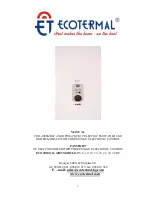
16
IX - GAs suPPLy PIPING
Check Gas supply
The gas pipe to your boiler must be the correct size for
the length of run and for the total BTU per hour input of
all gas utilization equipment connected to it. See
Table 4
for proper size. Be sure your gas line complies with local
codes and gas company requirements.
The boiler and its individual shutoff valve must be dis-
connected from the gas supply piping system during any
pressure testing of that system at test pressures in ex-
cess of ½ psig (3.5kPa).
The boiler must be isolated from the gas supply piping
system by closing its individual manual shutoff valve dur-
ing any pressure testing of the gas supply piping system at
test pressures equal to or greater than ½ psig (3.5kPa).
In order for proper operation of the boiler, it is recom-
mended that the line pressure be within the minimum and
maximum values in
Table 5
.
vIII - COmbusTION AIR AND vENT PIPE
NOTE: It is recommended that all pipes be
cut, prepared, and pre-assembled before per-
manently cementing any joint.
After pipes have been cut and pre-assembled, apply
7.
cement primer to pipe fitting socket and end of pipe to
insertion mark. Quickly apply approved cement to end
of pipe and fitting socket (over primer). Apply cement
in light, uniform coat on the inside of socket to prevent
buildup of excess cement. Apply second coat.
NOTE: Primer and cement will discolor jacket.
Take precautions to protect jacket while cement-
ing vent pipe.
While cement is still wet, insert pipe into socket with
8.
a ¼ turn twist. Be sure pipe is fully inserted into fitting
socket.
Wipe excess cement from joint. A continuous bead of
9.
cement will be visible around perimeter of a properly
made joint.
Handle pipe joint carefully until cement sets.
10.
Support combustion air and vent piping a minimum of
11.
every 5’ using pre-formed metal hanging straps. Support
combustion air and vent piping so no weight is resting on
the boiler jacket. Do not rigidly support pipes. Allow move-
ment due to expansion and contraction.
Slope combustion air and vent pipes toward boiler a
12.
minimum of ¼” per linear foot with no sags between
hangers.
Use appropriate methods to seal openings where vent
13.
and combustion air pipes pass through roof or side
wall.
TAbLE 5: GAs suPPLy PREssuRE
Natural Gas
4” min. w.c.
10” max. w.c.
LP Gas
10” min. w.c.
14” max. w.c.
Check line pressure while unit is running in high fire mode.
TAbLE 4: GAs PIPING sIZEs
Natural Gas
Pipe Length
Pipe Capacity - bTu/hr. Input Includes fittings
½”
¾”
1”
1¼”
20’
92,000
190,000
350,000
625,000
40’
63,000
130,000
245,000
445,000
60’
50,000
105,000
195,000
365,000
LP Gas
Pipe Length
Pipe Capacity - bTu/hr. Input Includes fittings
Copper Tubing (O.D.)
Iron Pipe
⅝”
¾”
½”
¾”
20’
131,000
216,000
189,000
393,000
40’
90,000
145,000
129,000
267,000
60’
72,000
121,000
103,000
217,000
The length of pipe or tubing should be measured from the gas meter or
propane second stage regulator.
















































